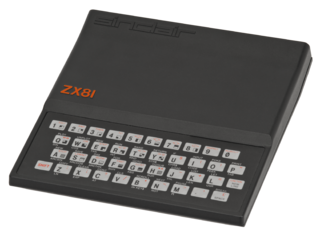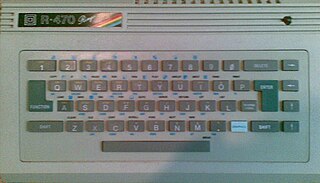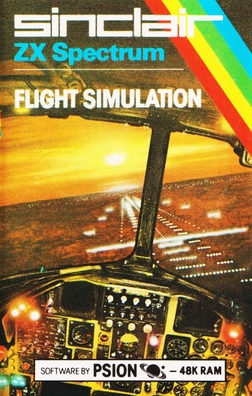The Sinclair QL is a personal computer launched by Sinclair Research in 1984, as an upper-end counterpart to the ZX Spectrum.

The ZX Spectrum is an 8-bit home computer developed and marketed by Sinclair Research. Considered one of the most influential computers ever made, it is also one of the best-selling British computers ever, with over five million units sold. It was released in the United Kingdom on 23 April 1982, and around the world in the following years, most notably in Europe, the United States, and Eastern Bloc countries.

The ZX81 is a home computer that was produced by Sinclair Research and manufactured in Dundee, Scotland, by Timex Corporation. It was launched in the United Kingdom in March 1981 as the successor to Sinclair's ZX80 and designed to be a low-cost introduction to home computing for the general public. It was hugely successful; more than 1.5 million units were sold. In the United States it was initially sold as the ZX-81 under licence by Timex. Timex later produced its own versions of the ZX81: the Timex Sinclair 1000 and Timex Sinclair 1500. Unauthorized ZX81 clones were produced in several countries.
Z88DK is a Small-C-derived cross compiler for a long list of Z80 based computers. The name derives from the fact that it was originally developed to target the Cambridge Z88. Z88DK is a collection of software development tools that targets the 8080 and Z80 family of machines. It allows development of programs in C, assembly language or any mixture of the two. What makes z88dk unique is its ease of use, built-in support for many Z80 machines and its extensive set of assembly language library subroutines implementing the C standard and extensions.
Sinclair BASIC is a dialect of the programming language BASIC used in the 8-bit home computers from Sinclair Research, Timex Sinclair and Amstrad. The Sinclair BASIC interpreter was written by Nine Tiles Networks Ltd.

The Timex Sinclair 1000 was the first computer produced by Timex Sinclair, a joint venture between Timex Corporation and Sinclair Research. It was launched in July 1982, with a US sales price of US$99.95, making it the cheapest home computer at the time; it was advertised as "the first computer under $100". The computer was aimed at regular home users. As purchased, the T/S 1000 was fully assembled and ready to be plugged into home televisions, which served as a video monitor. The T/S 1000 was a slightly modified version of the Sinclair ZX81 with an NTSC RF modulator, for use with North American TVs, instead of PAL for European TVs. The T/S 1000 doubled the onboard RAM from 1 KB to 2 KB; further expandable by 16 KB through the cartridge port. The T/S 1000's casing had slightly more internal shielding but remained the same as Sinclair's, including the membrane keyboard, which had modified nomenclature to suit American tastes Just like the ZX81, the T/S 1000 had black-and-white graphics and no sound.

The Timex Sinclair 2068, released in November 1983, was Timex Sinclair's third and last home computer for the United States market. It was also marketed in Canada, Argentina, Portugal and Poland, as Timex Computer 2068.
Sinclair Research Ltd is a British consumer electronics company founded by Clive Sinclair in Cambridge in the 1970s. In 1980, the company entered the home computer market with the ZX80 at £99.95, at that time the cheapest personal computer for sale in the United Kingdom. A year later, the ZX81 became available through retailers, introducing home computing to a generation, with more that 1.5 million sold. In 1982 the ZX Spectrum was released, becoming the UK's best selling computer, and competing aggressively against Commodore and Amstrad.

3D Monster Maze is a survival horror video game developed from an idea by J.K. Greye and programmed by Malcolm Evans and released in 1981 for the ZX81 with the 16 KB memory expansion. The game was initially released by J. K. Greye Software in December 1981 and re-released in 1982 by Evans' own startup, New Generation Software. Rendered using low-resolution character block "graphics", it was one of the first 3D games for a home computer, and one of the first games incorporating typical elements of the genre that would later be termed survival horror.
Timex Sinclair was a joint venture established in December 1982 between the British company Sinclair Research and Timex Corporation in an effort to gain an entry into the rapidly growing early-1980s home computer market in North America.

The TK 95 microcomputer was a 1986 ZX Spectrum clone by Microdigital Eletrônica, a company located at São Paulo, Brazil. It was an evolution of the TK90X introduced the previous year.

The Timex FDD 3000 in 1982 was a nearly complete computer by Timex of Portugal. It began its development at Timex Computer Corporation in the U.S., but it was at Timex of Portugal that the work was finished.

Ringo R-470 was a Brazilian clone of the Sinclair ZX81 by Ritas do Brasil Ltda. introduced in 1983. It featured a Z80A processor at 3.25 MHz, 8K ROM and 16 KB RAM. It wasn't 100% compatible with the ZX81, and some BASIC tokens have alternate codings.

The Unipolbrit Komputer 2086 was a Polish version of the home computer Timex Sinclair 2068, produced by a joint venture of the Polish state-owned Unimor and foreign company Polbrit International. Introduced in 1986, the computer had a cost of roughly 190000 zł.

Flight Simulation is a flight simulation program written by Psion and marketed by Sinclair Research for the ZX Spectrum and ZX81 home computers.
The TC 3256 or Timex Computer 3256 was a 1987 computer created by Timex of Portugal, a branch of Timex Corporation.

The ZX Spectrum Next is an 8-bit home computer, initially released in 2017, which is compatible with software and hardware for the 1982 ZX Spectrum. It also has enhanced capabilities. It is intended to appeal to retrocomputing enthusiasts and to "encourage a new generation of bedroom coders", according to project member Jim Bagley.
Tadeo Czerweny S.A. is an Argentinian manufacturer of transformers and other high-power electrical equipment founded by Tadeo Czerweny in 1958.














